Some Kinetoscope Films
of James H. White & William Heise
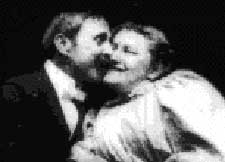 Kiss; aka, May Irwin Kiss; aka, The Irwin Rice Kiss (1896), filmed by William Heise ,must've seemed quite risque in the early days of the kinetoscopic movie era.
Kiss; aka, May Irwin Kiss; aka, The Irwin Rice Kiss (1896), filmed by William Heise ,must've seemed quite risque in the early days of the kinetoscopic movie era.
This three-quarters-of-a-minute film features Mary Irwin & John C. Rice kissing each other presumedy reenacting a scene which closes the play "The Widow Jones" by John J. McNally, though we don't actually have any context from the play, & the scene was selected for its naive sexploitation value.
The play was a runaway hit at Koster & Bial's Music Hall. It became the number one hit movie of 1896 thanks to attempts of amateur censors, who mainly got themselves ridiculed in the papers. Putting the "shameful" scene in a kinetoscope immortalized a tempest in a teapot. It's a sweet kiss, but they're a couple ugly mugs if ever.
Negatives eventually wore out & the strips shown in kinetoscopes did likewise, so films were often remade. The popularity of Kiss led to the remake The Kiss; aka, New Kiss (1900), a much sexier fifty seconds of cooin' & billin'.
The remake provided a semi-innocent peepshow for turn-of-the-century letches. If the players pecked at each other's faces any harder they'd've knocked out each others' teeth. The gal is unidentified, but the guy is Fred Ott, "star" of the absurdly popular Fred Ott's Sneeze (1894).
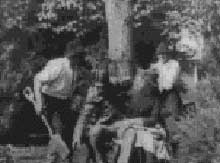 The same year William Heise had such a "hit" with the nothing-really-happens Kiss, James H. white put together a much more elaborate "story" of a kiss, with Heise as his camera man for Interrupted Lovers (1896).
The same year William Heise had such a "hit" with the nothing-really-happens Kiss, James H. white put together a much more elaborate "story" of a kiss, with Heise as his camera man for Interrupted Lovers (1896).
A brother catches his sister in a kiss & tells their father who comes at the luckless boyfriend with a shovel & gives the young man a good hard kick.
It's surprising how much character is invested in the four players, in just a few moments: the beau is a smoker, the brother is a vile young man laughing & laughing at screwing up his sister's romantic moment, dad's temper is bad enough he even kicks his suffering daughter. This was a time when films rarely had any characterization at all.
Even so, the incident is too slight even by the standards of the day, & all too often when films headed up by James H. White are compared to those headed up by Blackston or Porter, White just wasn't as good, despite that he was often the cameraman on better films & should've been learning from the best. White's forte was more in the area of films of place rather than of incident.
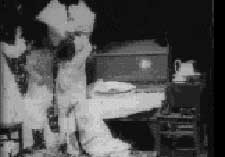 Seminary Girls (1897) was directed by James H. White, with help from William Heise on camera.
Seminary Girls (1897) was directed by James H. White, with help from William Heise on camera.
It's a half-minute of teens or tweens in their nightgowns having a pillow fight, with one girl climbing inside a pillowcase to hide when the school matron arrives to stop the chaos.
White & Heise must've really liked the subject as they did it twice in a row. In Pillow Fight (1897), four little girls in their bedroom are going at each other full tilt until the air is full of pillow feathers.
These two films of innocent mischief are unsettling only in that the primary clients for kinescopic films in the mid to late 1890s were men, not women or families, & the idea of guys standing in line for a peepshow of little girls in nighties is just too pervy.
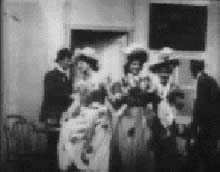 One of White's more intriguingly seedy films was Tenderloin at Night (1899). It is one of the very earliest crime films ever made, complete with femme fatales.
One of White's more intriguingly seedy films was Tenderloin at Night (1899). It is one of the very earliest crime films ever made, complete with femme fatales.
A simple cafe scene is shown with several patrons, mostly women, with the waiter coming & going from the kitchen. It's hard to tell but the tables appear actually to be on the sidewalk & it's an outdoor scene, though awfully bright to be the "night."
One of the two male patrons, with the ladies' encouragement, manages to drink himself unconscious & the ladies rob him. The other male present seems to know the ladies quite well (doubtless their pimp), but the theft is strictly their doing. The victim awakes to find his pockets empty.
The pimp stands up for the women's innocence & threatens the victim. A police officer arrives & takes the victim into the kitchen to hear his story, but when they come back out, he gets no satisfaction.
For climax the happy ladies begin dancing in a row. A close look reveals the little waiter dancing behind the women nearly completely obscured, as he was in on the deal.
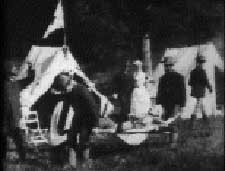 In Love & War (1899), a family man is a soldier, & says goodbye to what appears to be his wife, dad, & son, & kisses his infant farewell. In Love & War (1899), a family man is a soldier, & says goodbye to what appears to be his wife, dad, & son, & kisses his infant farewell.
The tragic battle scene that follows looks like a particularly lame day for reenactors; must've been chilly & not many bothered to come.
At the Red Cross hospital tents two nurses receive the wounded. At film's close, our family man has recovered from war injuries & is reunited with his loved ones.
This three minute film is deserving of three loud raspberries, as it scarcely makes any sense on the strength of its pictorial information alone. The original Edison catalog called this "an illustrated song" & it originally had six scenes, of which four survive. It mightn't've been much clearer if the other two scenes had survived, as knowledge of the song it illustrates would be the key to the action.
The Edison catalog, perhaps following the song, suggests an entirely different story: a man goes off to war promised a captaincy which he never receives, is wounded, but while recovering meets a nurse who becomes the love of his life. If that's really the story, then he must be saying goodbye to his sister & her bastard infant in the opening scene.
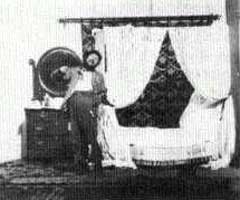 James Henry White was also a singer who recorded Edison cylinders, & the idea of the "Picture Songs" was his. Another of these was The Astor Tramp (1899). Though narratively faulty, it is one of the better films from White.
James Henry White was also a singer who recorded Edison cylinders, & the idea of the "Picture Songs" was his. Another of these was The Astor Tramp (1899). Though narratively faulty, it is one of the better films from White.
It opens in a rather nice bedroom with a hobo pacing the floor. The immediate mystery is what the heck is a hobo doing in such a nice bedroom, a woman's bedroom at that. At the vanity mirror he takes a drink of perfume then pours the rest on his head.
He lies down on the clean sheets of the bed just before housemaid comes into the room with a refined lady in hat & coat, the lady having just returned home. Her maid takes the hat & coat & leaves. Neither of them sees (or smells) the sleeping hobo.
The lady putters in her room for a bit then notices the tramp at last, & goes into a panic. The tramp wakes & tries to hide in the window curtains without actually getting up from the bed. A policeman soon arrives & while pulling the fellow out of the house, beats him with his baton just for the heck of it.
Most kinetoscope films would've regarded that as the climax but this is a two-minute feature & there's just time for another scene. The tramp is walking down the street & happens to have a coin to buy a newspaper from an urchin. He then kicks the kid off his block & seems to be hawking the paper one page at a time, without takers.
Contemporary catalogs describe an opening scene which established that the Tramp has actually wandered into the mansion of the founder of the Waldorf-Astoria hotel. The catalog further explains that the tramp got excited reading the newspaper because he was reading about a tramp having invaded the wealthy mansion.
An alternate description insists the story took place at the Waldorf-Astoria itself. Confusion is understandable since the narrative thread is unclear & requires knowledge of the song.
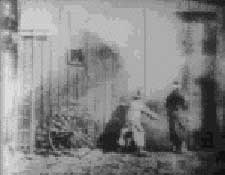 From the same team of White & Heise came Burning Stable (1896), a half minute of getting four horses & a wagon out of a burning stable. From the same team of White & Heise came Burning Stable (1896), a half minute of getting four horses & a wagon out of a burning stable.
It was in the main a variation of a W. L. K. Dickson American Mutoscope & Biograph film from earlier the same year, Stable on Fire (1896), which was more elaborately done as horses & cattle are being being saved & vehicles pulled away from the fire.
These films don't show real fires of course, but are early cases of realistic special FX, as opposed to FX for the sake of obvious "trick films."
Arthur Lubin plagiarised or remade pretty much the same film as Stable on Fire (1903), getting some startled responses from the horses being saved from the faked stable burning.
Lubin's version was re-edited after the great conflagration in Maryland as part of The Great Baltimore Fire (1904), which must've been maddening to to American Mutoscope which had in the same month issued A. E. Weed's identically titled The Great Baltimore Fire (1904).
Firemen subjects were a big film genre, about which I've written much more in the article on Life of an American Fireman (1903) & related sorts of films.
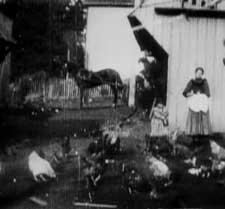 Feeding the Doves (1896) by White & Heise provided a half-minute of watching the pigeon lady & a young girl feeding pigeons & the chickens (but no doves, hence the later-imposed alternate title Feeding the Chickens.).
Feeding the Doves (1896) by White & Heise provided a half-minute of watching the pigeon lady & a young girl feeding pigeons & the chickens (but no doves, hence the later-imposed alternate title Feeding the Chickens.).
It's a staged event to create an "actuality film," a genre that would die out only when films were taken so for granted that it was no longer sufficient to provide moving photographs without much more serious action or a narrative of some sort.
A lot of what White produced with Heise as cameraman seems to have been cribbed from elsewhere. You wouldn't think there's enough of a film with Feeding the Doves to justify it being a remake, but in fact that's what it is. The Lumiere brothers released pretty much the same scene earlier in the year.
The inexplicable popularity of both the Lumiere & the Edison versions induced at least two further versions from other studios, which apparently don't survive.
Presumedly the migration into American cities that occurred at the start of the industrial revolution left many people nostalgic for the barnyard. Thus they were willing to pay a penny or a nickel for the view.
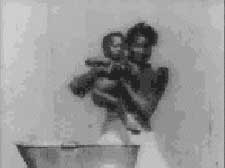 Similarly, White & Heise remade Dickson's Biograph picture A Hard Wash (1896) as Morning Bath (1896). Similarly, White & Heise remade Dickson's Biograph picture A Hard Wash (1896) as Morning Bath (1896).
Since Thomas Edision had only recently fired Dickson, the true inventor of the Kinetograph & Kinetoscope, it seems likely that White & Heise's tendency to so swiftly plagiarise from Biograph was part of a dubious mission to mischief against the guy who used to be their boss.
Morning Bath is a half-minute of watching a black woman bathe the baby. The title was probably intended to fool horny guys into thinking they might see a woman bathing if they plunked their coin in the kinetoscope & pressed their eye to the hole.
Apparently the racist "joke" is that the mother can't wash the blackness off her baby's skin, but when I first saw this it never occurred to me that was the intent, it just looked like a vigorous bath.
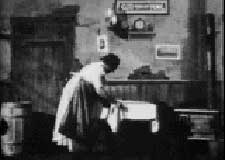 James H. White appears rather more original with Grandma & the Bad Boys (1900).
James H. White appears rather more original with Grandma & the Bad Boys (1900).
A one-minute of comedy, two lads fill a container with flour & set it upside down on a high shelf ledge, knowing that when grandma takes it down, it will empty out all over her head.
Covered in flour, she grabs the boys out from under the table where they've hidden to watch, & gives them a good pointing-at.
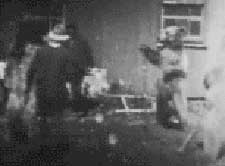 In such comedies of "bad" boys, they frequently end with a spanking, but it appears that James White didn't approve of that. In such comedies of "bad" boys, they frequently end with a spanking, but it appears that James White didn't approve of that.
Trick Bears (1899), at just over two minutes, captures what appears to be a family circus act with three trained bears. The bears obediently sit on chairs, wear clothes, walk about in circles.
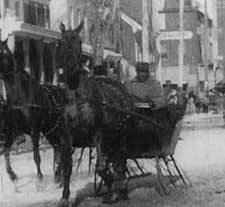 It's cute, but the bears are controlled the painful way with leashed rings piercing their noses, so they're actually being tortured. It's cute, but the bears are controlled the painful way with leashed rings piercing their noses, so they're actually being tortured.
A snowy city street in the wake of a Pennsylvania snowstorm is shown with horse-drawn vehicles, then with a speeding horse-drawn sleigh, in The First Sleigh Ride (1897).
It's only a half-minute film but full of action, a second horse-drawn vehicle following the sleigh at a rapid clip, with lots of people standing about in the snowy street.
This is an appealing scene for movement & content that can still delight even today, & in 1897 when "motion" pictures were so new, it must've been just stunning.
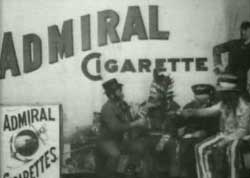 One money-making use of early film was in advertising, & William Heise's Admiral Cigarette (1897) is a half-minute comedy vignette with the sole purpose of pitching the product.
One money-making use of early film was in advertising, & William Heise's Admiral Cigarette (1897) is a half-minute comedy vignette with the sole purpose of pitching the product.
Georges Melies had done "product placement" in his short-short films, to get extra funding to make films. The Edision company just as quickly realized that featuring Edison inventions & Edison himself in films was good advertising for all arms of the company. But Admiral Cigarette appears to be the first film produced exclusively as an advertisement beginning to end, & certainly the first such registered for US copyright.
Four gentlemen of various stations in life (including an Indian & Uncle Sam) are sitting below the Admiral Cigarette signboard.
To their right (our left) stands a giant-sized cigarette box. The box unexpectedly bursts open & a woman in tights hops out, handing out free cigarettes. The gents unroll a banner that reads, "We All Smoke."
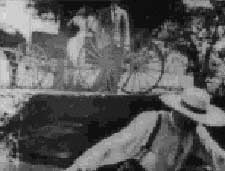 An episode from a stage play based on Henry Wadsworth Longfellow's "Evangeline" is given as The Lone Fisherman (1896). The film recreates the play's most famous moment, which occurs nowhere in Longfellow's poem.
An episode from a stage play based on Henry Wadsworth Longfellow's "Evangeline" is given as The Lone Fisherman (1896). The film recreates the play's most famous moment, which occurs nowhere in Longfellow's poem.
Films from White & Heise tended to be fairly bad compared to those of the recently jettisoned William Dickson, & way inferior to what Edwin Porter would be doing when he showed up in 1900. But with The Lone Fisherman the team of White (producer) & Heise (cameraman) managed a surprisingly good film.
The pastorality of the fisherman in his big straw hat fishing off the bridge, sitting above the river bank, is so evocative you can almost hear the birds singing & the water plashing. It is, however, the tale of a practical joke, & the lone fisherman does happen to have been drinking.
The fisherman has placed a heavy rock on a board, & the board sticks out over the water away from the bridge. He's sitting on the board with his bottle of beer & his fishing gear. A man sneaks up on him & knocks the rock off the board, sending the hapless fisherman into the drink, just as a horse & buggy goes by.
The buggy stops & the man steps down (a woman stays in the buggy), sharing a good laugh with the practical joker, while the fisherman tries his best to splash them both.
It could be seen as rather more mean than funny, but the joker is obviously a friend, & when the fisherman crosses to the far bank to leave in anger, the joker jumps in the water too, wading across to go after the guy.
This goodhearted touch makes the film a lot richer than I usually expect from James White films, though if one looks hard enough some good natured things can be spotted in other of his films, like Grandma & the Bad Boys when the boys don't get a well deserved spanking.
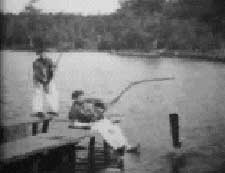 The authentic setting, the naturalistic acting, & the final note of humanity in The Lone Fisherman lend it strength & significance. The authentic setting, the naturalistic acting, & the final note of humanity in The Lone Fisherman lend it strength & significance.
Heise produced the similarly pastoral comedy Fisherman's Luck (1897). The two fishermen have crooked branches for fishing poles. One man's sitting, the other standing out on the end of a dock on a pleasant day.
The seated fisherman catches a rusty stove pipe & as he pulls violently on the line, the pipe is flung onto the dock. The other fisherman is so startled he falls into the lake.
As a rowboat eases past in the background, the soggy fisherman makes his way back onto the dock. They ought to stick this one on the end of a bunch of "fall in the drink" clips on America's Funniest Home Videos.
copyright © by Paghat the Ratgirl
|
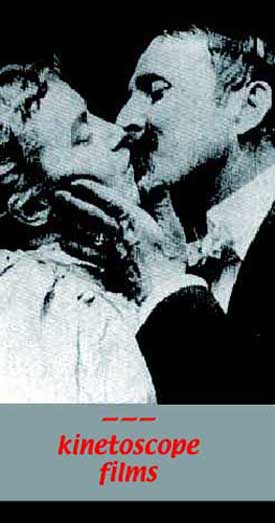










 In such comedies of "bad" boys, they frequently end with a spanking, but it appears that James White didn't approve of that.
In such comedies of "bad" boys, they frequently end with a spanking, but it appears that James White didn't approve of that. It's cute, but the bears are controlled the painful way with leashed rings piercing their noses, so they're actually being tortured.
It's cute, but the bears are controlled the painful way with leashed rings piercing their noses, so they're actually being tortured.

 The authentic setting, the naturalistic acting, & the final note of humanity in The Lone Fisherman lend it strength & significance.
The authentic setting, the naturalistic acting, & the final note of humanity in The Lone Fisherman lend it strength & significance.